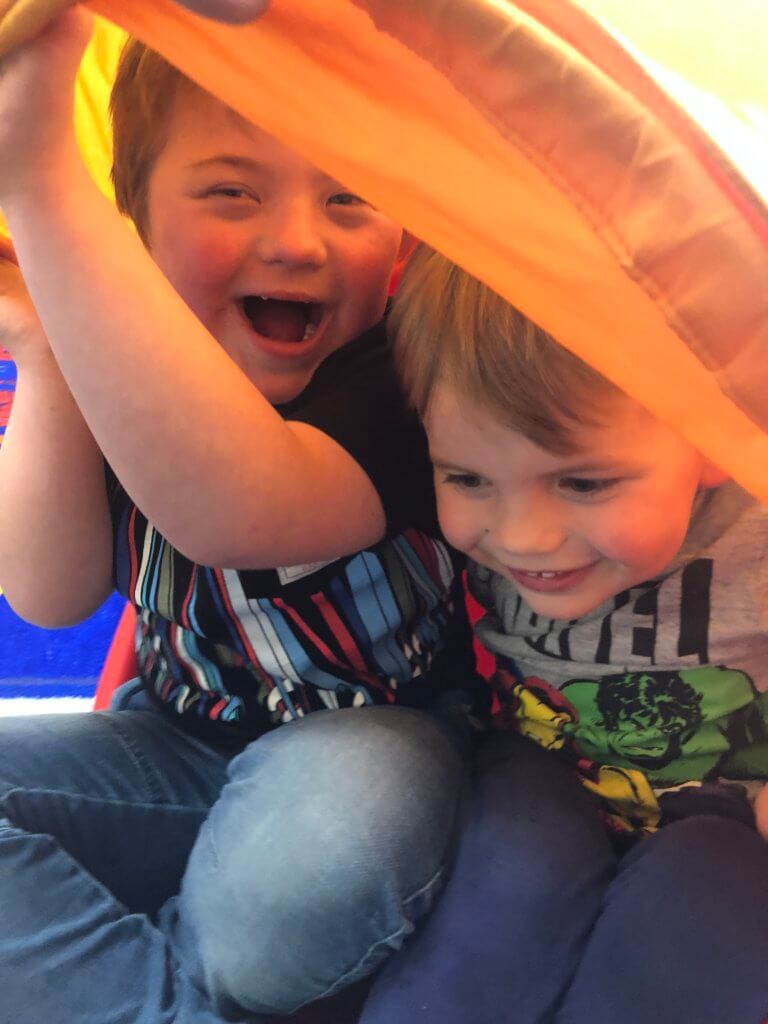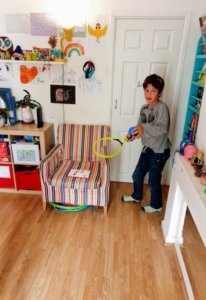9 Sports to Play at Home for Children With Down Syndrome
Sport is a great way to get exercise. As well as improving strength and stamina, sport is known to boost confidence and self-esteem. It’s also lots of fun!
While most children with Down Syndrome learn to walk, many struggle with higher level physical activities that require more coordination and dexterity. Because of this, they may be inclined to shy away from sports.
Participating in fun sports-related activities from a young age is a great way for our child to build their skills, coordination and their confidence. This will also make them more likely to engage with exercise as they grow.
Below we share whole host of sporty ideas we can try with our child at home. They are best for children who are walking, though some can be played sitting. Some games can be played with several children present (great if siblings want to get involved!). However, many can be played one on one with our child, or just with our child playing alone.

Sport to play at home
When playing ball games, balloons or rolled up socks can be more ‘home-friendly’ than regular balls.
Set up a volleyball court with a piece of string between two walls, or between two chairs. You’ll also need a balloon or softish ball.
The aim of the game is to make the balloon/ball touch the floor on your opponent’s side of the string.
If your child has less accurate arm function a corridor is a good place to set up your court as the walls keep the balloon in reach.
For more physical children, we can set this up in the middle of a room or in the garden between two chairs to encourage more activity.
To make your ‘net’, set up a laundry basket or draw a circle on a piece of paper and stick it to the wall or the floor. As hand-eye coordination can be a problem for children with Down Syndrome, make the ‘net’ large so your child can be motivated by their success.
Throw a ball into the net to score a goal. Start nice and close so your child is successful. As their hand eye coordination improves, try this from different places – getting further away with each successful shot.
Set up ten bowling pins in a triangle shape – use toilet roll tubes or empty plastic bottles if you don’t have skittles.
Throw objects at the skittles to topple them. See how many tries it takes to knock them all down.
Get further away from the skittles as your child improves.
Try this with your child in some different positions – on their hands and knees or up high on their knees to work their muscles further.
This is a fabulous and fully inclusive sport similar to Bowles. See this Our Home video which explains how to play the game.
In this version of hockey, you dribble a balloon (the ‘puck’) using your hands (the ‘stick’).
For a single child game, you could set up an obstacle course with chairs and a goal at the end.
For a sibling game, try to steal the balloon off each other to head for goals at opposite sides of the room/ garden.
For a more dexterous child, keeping the balloon in the air while they crawl around the house will keep them entertained and use up lots of energy.
 This great series Tennis at Home done by the Lawn Tennis Association (LTA) provides simple ideas to practice your tennis skills in your back garden or in a room with a few meters of space.
This great series Tennis at Home done by the Lawn Tennis Association (LTA) provides simple ideas to practice your tennis skills in your back garden or in a room with a few meters of space. If you don’t have a tennis racket you can still try these games with a fly swatter, any other kind of bat, a roll of wrapping paper or a broom. You could use socks, a balloon or scrunched up paper instead of a ball.
The activities vary in difficulty but most can be played from sitting or standing.
Table cricket is played by people with all disabilities. It is a great game to play with all the family and can be played using a regular table.
This video Keeping fit and healthy at home: Table top tennisgives a quick demonstration of how to set up and play table cricket in the home.
Visit this video by the Lords Taverners Lord’s Taverners | Rules of Table Cricket for more detailed explanations of how to play this great inclusive game.
Football is a fantastic sport to play for children with Down Syndrome as it works their pelvic stability and core stability – both areas which can be weak with our DS children. It is also a game that can be played with few or many – giving your child the opportunity to play a sport with their peers, no matter their level.
Start with standing still and just passing a ball between you. They may need to hold onto something to keep their balance to start with so set them up to succeed by giving them the opportunity to hold onto something to stabilise themselves.
Using a balloon to start with may give them time to be able to aim – slowing the game down for a more successful session.
Move on to dribbling the ball from one side of the room to the other. This will involve lots of standing on one leg which is great for their balance and pelvic stability.
As they improve their balance and their kicking skills, make an obstacle course which your child needs to dribble a ball around. Depending on their skills, they could go around objects or furniture or even try to shoot between 2 chairs as goals.
Bristol Bears Community Foundation have created this fantastic series for those with more profound learning needs. They use very simple language and makaton, give plenty of time for processing information and have a lovely variety of activities to try or engage with.
Here we have an example of their first exercise session. Join in with as much as you can and help your child to move where possible.
You can see all of Bristol Bears videos on their YouTube Channel






